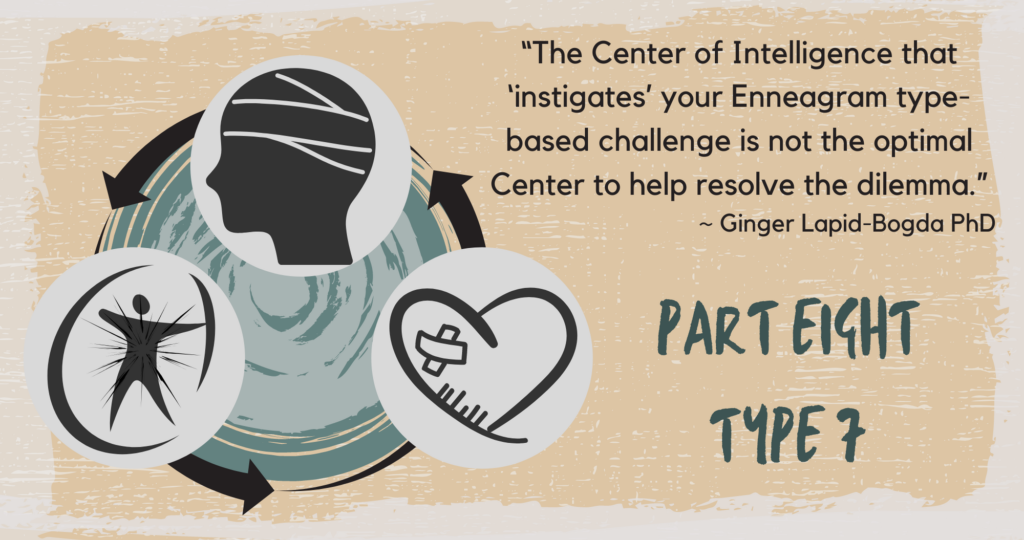Although this statement may sound counter-intuitive, over years of working with people and groups on the Enneagram-based development, this has proven to be more accurate than not. Of course, working with the Center of Intelligence that instigates the challenging dynamic can be effective, it is simply more difficult. If the Head Center is the instigator, can the Head Center easily change course? To clear the Mental Center, soothe the Heart Center, or calm or embody the Body Center, another Center of Intelligence can be called into service to help support the desired growth and transformation.
This 9-nine-part blog series will clarify this developmental idea for each of the 9 Enneagram types, with this blog focusing on Enneagram type Seven.
A common type Seven development area
Staying focused
Staying focused can be challenging for all of us, no matter our Enneagram type. Repetitive tasks become boring, even if we had some initial interest in doing them. New ideas can be stimulating, but even too many new ideas can become boring if all we are doing is being idea generators. Repetitive feelings, even ones we might describe as positive, can also become tedious. We all crave newness – some of us more than others.
All that said, staying focused is a primary challenge for almost all Sevens. Some Sevens may say they can focus, but they often mean they can now focus longer than they used to, but that may still not be for very long, and it still takes effort. I’ve met a few Sevens who say as children they absolutely had to learn to focus, so they themselves set up clever reward systems; set up this task, complete it and give myself a specific reward that I’ve determined in advance such as an ice cream cone, playtime with a special friend, a specific amount of time on a favorite video game, just as examples. However, these Sevens are the exception.
So what Center of Intelligence ‘instigates’ the challenge of staying focused? Deep inside, it starts in the Heart Center although the pattern may appear to be the Head Center or Body Center, and for several reasons. First, everything happens so quickly with Sevens that It can be a challenge to determine the starting point. In addition, the Head Centers kicks in so rapidly with an abundance of ideas and the Seven’s body (Body Center) appears to be in constant motion.
This particular Seven pattern, however, forms as a mechanism to not stay with one’s inner experience and, in particular, the inner emotional experience (Heart Center). One way of understanding the Sevens’ challenge with focusing is that it is a way of deflecting emotional experience, particularly sadness and fear but also, to some extent, anger. Being unfocused allows Sevens to minimize that which they find difficult and maximize being stimulated through interesting and pleasurable thoughts and activities.
One way that works is to make focusing a doable challenge and to make it fun, as if a game of sorts. It’s akin to what some Seven children taught themselves to do at an early age. Starting with the Body Center as an anchor and using the Head Center as a support, stay still and focused on anything you choose while timing yourself with a timer. Determine your length of being able to focus on what you have chosen naturally. Do this again at least two more times, selecting something else to focus on while timing yourself as you do it in a focused way. This gives you three different instances of your natural focusing length. Your Body Center helps you stay still and focused; your Head Center assists you in tracking time and making decisions.
Once you have your baseline for focusing, you have some decisions to make and here they are. First, how much longer than your baseline focusing time do you want to extend your ability to focus that is realistic yet also a stretch? In other words, if your baseline is three minutes, 10 minutes is too big a stretch. Try extending your focus for a total of five minutes instead. Or, you might want six minutes, but 10 minutes is simply too much. Before you engage in this challenge, set up a reward for yourself each time you do it, but no punishment for not! And make sure you give yourself the reward. After you experience yourself being able to focus much more easily for longer than the initial time you set as a stretch goal, then extend the time even more, also setting up a reward, but it’s best if the reward is a new and different one. Most of all, have fun with this!
Ginger Lapid-Bogda PhD, author of eight Enneagram books, is a speaker, consultant, trainer, and coach. She provides certification programs and training tools for business professionals around the world who want to bring the Enneagram into organizations with high-impact business applications. TheEnneagramInBusiness.com | ginger@theenneagraminbusiness.com


Comments are closed.